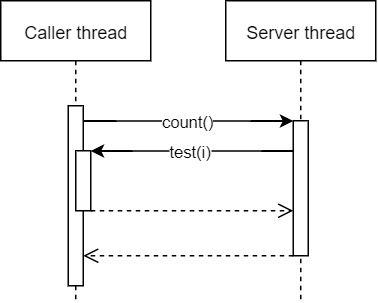Request back dispatch
Disclaimer: the example in this article is only for showcasing the back dispatching feature. It is not efficient, and there are more performant ways to achieve the same goal.
There may be many cases when you call a method over the RMI connection, and during the serving of that request, the implementation will issue another call back to the caller. One simple example for this:
public interface Stub {
public int count(IntPredicate predicate);
}
public class Impl implements Stub {
private List<Integer> items;
@Override
public int count(IntPredicate predicate) {
int c = 0;
for (Integer i : items) {
if (predicate.test(i)) {
++c;
}
}
return c;
}
}
In the above example we have a scenario where the count() method counts the number of elements that match a given predicate. When the count() method is called on an RMI proxy, and the passed predicate is an RMI proxy as well, then every test() call will cause another request to be made over the connection. In order to ensure proper operation, the RMI runtime needs to dispatch the back-requests to the originating thread. The following sequence diagram showcases how the operation will go down:

You can see that the test() method is invoked on the same thread that issued the count() method call.
This behaviour is especially important, as not invoking the back-requests on the same threads could easily cause deadlocks. For example if the caller works as follows:
private final Stub stub;
private int mod;
public synchronized int getCount() {
return stub.count(i -> {
synchronized (this) {
return i % mod == 0;
}
});
}
public synchronized void setMod(int mod) {
this.mod = mod;
}
We have a thread-safe client that uses the stub remote object to perform some operations. The getCount() method is synchronized, allowing only a single thread to call it at the same time. It calls the impl.count() method, which will initiate an RMI network request, and waits for the result.
If back dispatching didn't exist, the first time the implementation calls test(), the system would deadlock. It would deadlock, as the test() call would run on a different thread than the one running getCount(), therefore couldn't enter the monitor of this.
The back dispatching solves this issue, and comes with an another advantage that the same thread resources are available for back-dispatched requests as the initiating caller. (This is important if ThreadLocals are used.)